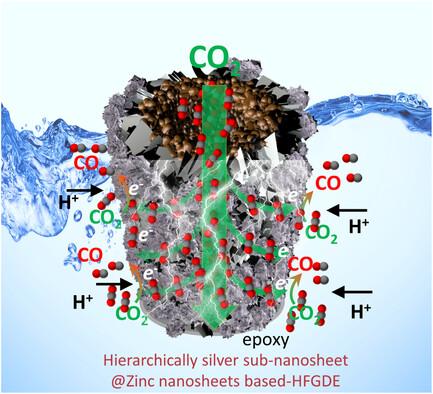在锌纳米片基中空纤维气体扩散电极上原位生长分层银亚纳米片,用于电化学将二氧化碳还原为二氧化碳
IF 11.1
Q1 MATERIALS SCIENCE, MULTIDISCIPLINARY
引用次数: 0
摘要
二氧化碳的电化学还原(CO2RR)是一种有效的策略,可减轻碳排放效应并将可再生电力储存在增值原料中,但其生产率和电流密度仍然较低。纳米结构催化剂通过提供大量活性位点和促进电荷转移,为提高 CO2RR 活性提供了机会。本文报告了一种在锌纳米片结构上带有银子纳米片的铜中空纤维气体扩散电极(HFGDE),用于生产 CO。与仅具有锌纳米片结构的高频气体扩散电极相比,制备的具有分层亚纳米银锌双金属纳米片的高频气体扩散电极在外加电位-1.3 V(相对于可逆氢电极)下的一氧化碳电流密度和一氧化碳产生率是其两倍。独特的 Ag 亚纳米片与 Zn 纳米片相互连接,提供了多个电荷转移通道,Ag 和 Zn 之间的协同效应提高了 COOH* 中间体的吸附结合能,从而降低了电荷转移电阻,加快了 CO2RR 生成 CO 的动力学过程。这项研究证明了纳米工程电催化剂在高频炉气脱硫中实现高效二氧化碳还原的巨大潜力。本文章由计算机程序翻译,如有差异,请以英文原文为准。

In Situ Growth of Hierarchical Silver Sub-Nanosheets on Zinc Nanosheets-Based Hollow Fiber Gas-Diffusion Electrodes for Electrochemical CO2 Reduction to CO
Electrochemical reduction of CO2 (CO2RR) is an effective strategy to mitigate carbon emission effects and store renewable electricity in value-added feedstocks, but it still suffers low production rate and current density. A nanostructured catalyst offers opportunities to enhance CO2RR activity by contributing numerous active sites and promoting charge transfer. Herein, a Cu hollow fiber gas diffusion electrode (HFGDE) with silver sub-nanosheets on a zinc nanosheet structure to produce CO is reported. Compared to the HFGDE only possessed zinc nanosheet structure, the as-prepared HFGDE with hierarchical sub-nano AgZn bimetal nanosheets exhibits a twice-partial current density of CO and a CO production rate at the applied potential −1.3 V (versus reversible hydrogen electrode). The unique Ag sub-nanosheets interconnected Zn nanosheets provide multiple charge transfer channels, and the synergistic effect between Ag and Zn improves the adsorption binding energy of COOH* intermediate, resulting in a lower charge transfer resistance and fast CO2RR kinetics to produce CO. This research demonstrates the high potential of nanoengineering electrocatalysts for HFGDE to achieve highly efficient CO2 reduction.
求助全文
通过发布文献求助,成功后即可免费获取论文全文。
去求助
来源期刊
CiteScore
14.00
自引率
2.40%
发文量
0
期刊介绍:
Small Science is a premium multidisciplinary open access journal dedicated to publishing impactful research from all areas of nanoscience and nanotechnology. It features interdisciplinary original research and focused review articles on relevant topics. The journal covers design, characterization, mechanism, technology, and application of micro-/nanoscale structures and systems in various fields including physics, chemistry, materials science, engineering, environmental science, life science, biology, and medicine. It welcomes innovative interdisciplinary research and its readership includes professionals from academia and industry in fields such as chemistry, physics, materials science, biology, engineering, and environmental and analytical science. Small Science is indexed and abstracted in CAS, DOAJ, Clarivate Analytics, ProQuest Central, Publicly Available Content Database, Science Database, SCOPUS, and Web of Science.

 求助内容:
求助内容: 应助结果提醒方式:
应助结果提醒方式:


